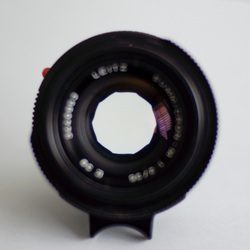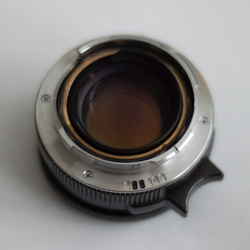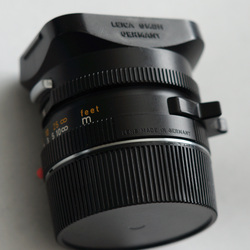


| LeicaLux |
|
A path not to be taken lightly, not without reservations, and not without dedication, but the results can be sweet, OH SO SWEET! This is a documentation of my trials and tribulations into the world of Leica Rangefinder Photography, and I hope you'll enjoy coming along with me.
|
This is a lens with a legendary reputation. I believe it was Mike Johnston, who crowned it the "King of Bokeh" [HERE], for it's smooth transition and rendering of the out-of-focus area. I, of course, could not pass up the chance of owning one, even if it's just for the opportunity to try it out. I bought it when I was still shooting with the Sony NEX camera, and it was perfect because due to the 1.5 sensor crop factor, it gave me the 50mm standard field of view. Being a 50mm-FOV type of guy, I don't use it as much with the M9, unless I find myself needing a wide angle lens. I hope one day I will learn to use the 35mm FOV better and use it more.  One thing I want to point out right away, is the fact that its aperture iris at f/2 (wide-open) is not a fully rounded circle (see picture). Having owned a few Voigtlander and Zeiss lenses before, I'm used to having the aperture blades retract completely at the wide-open position, exposing a complete circle. You can imagine my shock and panic, since I bought mine second hand, I thought I had received a defective copy. After searching everywhere on the internet and posting in forums to ask other owners of the same lens to verify, I've collected enough evidence to convince me that it's normal. Since the shape of the bokeh is affected by the shape of the aperture iris, I'm just amazed that this fact isn't very well documented, given it's title and reputation.  Another thing I'll point out, is that it's not easy to have this lens 6-bit coded for M8 and M9. The reason is because on the original mounting plate, there is a screw hole right in the place where normal 6-bit coding is located. As you can see, my lens has a custom mounting plate that doesn't have the screw hole so I'm able to 6-bit code this lens properly. However, this means the plate is screwed onto the lens with one less screw then normal. I haven't noticed any problem with it, and I do have the original mounting plate and the extra screw so I can put everything back if there are problems in the future, or if I decide to sell it.  If you search for this lens, you'll notice that most of what you find are made from Canada. This lens was produced for almost 20 years. During the first half of its production, it was produced out of Midland, Ontario, Canada, and then the production was moved to Solms, Germany. In actual usage, there should not be any difference between the two, however, the collectors in us give a slight preference to the German-made copies. Also, since the ones made in Germany are made later, they usually can be found in better condition, which also help them to demand a higher price. UPDATE: I have since replace the original hood that has the silver buttons with the hood from the 28mm Elmarit-M ASPH (part #12 526). They are exactly the same size, except the new hood has black buttons and provide better grip for the plastic hood cap. Also, since they are similar in size, I kept the leather pouch for this baby when I sold the 28mm.
4 Comments
keanu
3/9/2014 08:57:33 am
Thank you for a nice review and great tip about using the more modern hood.
Reply
Dave
3/28/2015 04:28:18 am
I found your post after researching the position of the aperture blades on this lens when wide open. I had a few shots where the bokeh was in the center of the frame and I could see the pattern of the blades (shot at minimum distance and f/2). I also thought my lens had a problem, but I guess it's normal. Interestingly enough, off center out-of-focus areas show near perfect circular bokeh.
Reply
Tee
1/22/2018 08:30:16 pm
FYI: regarding the Boheh, at exactly f2.0 the shape of the Boheh is indeed not perfectly circular ; But if you rotate it ever slightly to the left of f2.0 ( per half f1.9 :-) : the bokeh would very much be close to perfectly circular... Your comment will be posted after it is approved.
Leave a Reply. |
AuthorDavid Young Archives
October 2023
Categories
All
|
